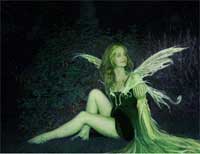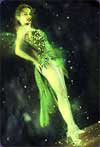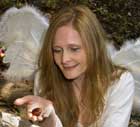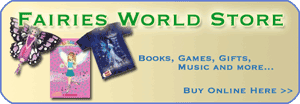The Absinthe Green Fairy

Myrea Pettit as Absinthe The Green Fairy-La Fée Verté Clouded in mystery the Absinthe Green Fairy or La Fée Verté was certainly the friend of artists and authors. She exposed herself in Paris in the heady days of the impressionists who fell under her spell casting her image and fairy magic in the drink Absinthe building their reputations and fame worldwide as she wormed her way into their psyche.

Kylie Minogue as the Green Fairy
In fact it was Oscar Wilde who sums it up perfectly
"The first stage is like ordinary drinking, the second when you begin to see monstrous and cruel things, but if you can persevere you will enter in upon the third stage where you see things that you want to see, wonderful curious things."
"Absinthe has a wonderful colour, green. A glass of absinthe is as poetical as anything in the world. What difference is there between a glass of absinthe and a sunset?" --Wilde
the power and attraction of absinthe lies in its inherent contradictions, though fortified with a formidable measure of alcohol, a depressant, it is also infused with powerful herbal stimulants, creating a psychic tug of war in the mind of the imbiber. Alcohol relaxes inhibitions and invites in new ideas, and the stimulants allow you to logically process the new data.
The Cult of the Wormwood
The psychoactive chemical at the heart of the herb wormwood is the stimulant thujone, which along with anisette, gives absinthe its bitter, black liquorish taste.
While once thought to instigate similar reactions as marijuana's THC recent research suggests it modulates the neurotransmitter GABAA, which plays a vital role in cognitive thought. Subsequently, absinthe provides a level of clarity to fire the imagination not usually associated with alcoholic drinks, just what any creative artist or author needs.
Wormwood
Artemisia absinthium
Botanical Painting from F. E. Kohler's
"Medizinal-Pflanzen", 1888
.
Strange Rituals and Green Hours
Hemingway took his first taste while visiting Spain in 1920. He fell head-over-heels in love with the Faerie, continued the habit in Paris (though it was illegal at the time), then carried the practice home to the U.S. He smuggled bottles from Spain and Cuba and kept it by his typewriter as a means of instant inspiration.
Absinthe originated in Switzerland as an elixir, used in a similar capacity as patent medicine would be used later in the United States. In its heyday, the most popular brand of absinthe worldwide was Pernod Fils. By 1915, it was banned in a number of European countries and the USA. Even though it was vilified, no evidence shows it to be any more dangerous or psychoactive than ordinary alcohol. A modern absinthe revival began in the 1990s, as countries in the European Union began to reauthorize its manufacture and sale.
The Return of the Faerie
"Let me be mad, mad with the madness of Absinthe, the wildest, most luxurious madness in the world." ‹Marie Corelli
Links to interesting sites
|





 Del.icio.us
Del.icio.us

